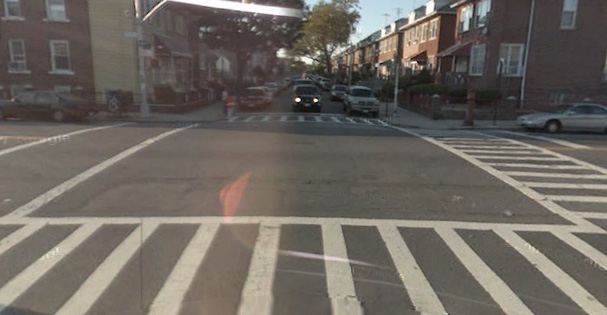Here are a dozen questions pertaining to the crash that took the life of 16-year-old Stuyvesant H.S. student Aileen Chen as she rode her bicycle last Saturday a block from her home in Borough Park at around 6 p.m.
- How fast was the BMW traveling when Aileen and her bicycle first came into view?
- How fast was the driver going when he struck her?
- How far from the point of first impact did Aileen’s body come to rest?
- Was the 26-year-old driver alone, or were there others in the car?
- Was she hurrying for some reason, or distracted?
- Has the driver’s smartphone been impounded and checked to see if she was phoning or texting at the time of the crash?
- Is the area of Borough Park in which the crash took place residential, as it appears from an Internet view?
- How long and far from the collision might a driver who had been visually scanning the road have seen Aileen?
- Which party was traveling on 21st Avenue, which appears wider and perhaps more prone to fast driving than the cross street, 62nd Street?
- Does the driver have a record of moving violations?
- Whose testimony was the basis of the NYPD statement that Aileen ran a red light?
- Did anyone other than the driver witness the crash? Has the NYPD taken their evidence?
Every one of these questions is answerable, although none were answered in the press accounts, which nevertheless drip with the customary “victim guilty, case closed” quality of articles about bicyclist fatalities. All of these questions, I submit, are relevant to finding fault — a process that, though painful, is essential, as it is in every serious-injury or fatal traffic crash, to the arduous task of reforming traffic engineering, enforcement, jurisprudence and behavior.
The foundation of any meaningful investigation of the crash that killed Aileen is found in the first three questions. Driving faster than 30 mph on ordinary streets such as the two that intersected here is both prohibited by law and a statistical separator between surviving being struck by a car, and not. Higher driving speeds also increase crash likelihood by making visual scanning less effective, shortening drivers’ reaction-time window, lengthening stopping distance, and impeding detection of the vehicle by other road users.
Presumably the NYPD Accident Investigation Squad, the unit charged with analyzing fatal crashes in NYC, has by now measured skid marks, other road markings, damage to the BMW and bicycle, and the locations where Aileen and her clothing, iPod, etc. came to rest. From these metrics, the AIS may have already calculated, at least approximately, the driver’s speeds prior to and during the collision. Yet there is almost zero chance that these data from Aileen’s crash will enter the public record. The NYPD guards AIS reports virtually as state secrets. In 2000, when my organization Right Of Way was researching our "Only Good Cyclist" report on fatal NYC auto-cyclist crashes [PDF], prying loose AIS reports for a mere 14 crashes required multiple iterations of our Freedom of Information request, plus a dozen subsequent calls and letters. Several similar requests proffered later were rejected.
Questions 4 and 5 go to the driver’s state of mind and, while purely circumstantial, may suggest a possible motive to speed or otherwise drive carelessly. Though neither hands-free phoning nor texting while driving is illegal in New York State (the latter is a secondary not primary driving offense), the driver’s quality of attention is still a critical parameter, which justifies Question 6.
Question 7 draws on the legal obligation of drivers to observe a standard of due care. (Section 1146 of the State Vehicle & Traffic Law directs “Drivers [to] exercise due care to avoid colliding with any bicyclist, pedestrian or domestic animal upon any roadway.”) By law, then, operating a motor vehicle in a residential neighborhood requires being on alert for people walking, running, playing, cycling, etc. Question 8, another for the Accident Investigation Squad, seeks to determine if a lawful driver (speed limit, due care, etc.) could have averted striking a cyclist who had ridden through a red light.
Questions 9 and 10 return to the subject of the driver’s cognition and conduct, while questions 11 and 12 seek to address the vexing and perhaps unresolvable issue: Who had a green light and who ran a red — Aileen or the driver? I suspect that this question will never be settled. Self-interest requires the driver to claim that he had right of way. And while any eyewitnesses should be tracked down and interviewed, bystander accounts aren’t always reliable, and it’s not unreasonable to worry that cultural biases about drivers and bicyclists could inadvertently color their accounts. At the least, though, if the only reported account is the driver’s, its bias should be acknowledged and its testimony disregarded.
No answers will bring back Aileen, whose tragically abbreviated life was so vibrant and promising. But determining the circumstances of her fatal crash as definitively as possible is important to the public discourse and, ultimately, public policy, that determines whether our streets will be dangerous or livable. Between the Post’s “Tragic teen struck and killed was biking against light: cops” and an alternative headline, “Joyrider in BMW was speeding when he rammed teen on bike,” lies a world of difference. For now, we don’t know which applies. Without data that the NYPD may have but won’t give out, we probably never will.






